
Wasps in the family Pompilidae are commonly called spider wasps, spider-hunting wasps, or pompilid wasps. The family is cosmopolitan, with some 5,000 species in six subfamilies. Nearly all species are solitary, and most capture and paralyze prey, though members of the subfamily Ceropalinae are kleptoparasites of other pompilids, or ectoparasitoids of living spiders.
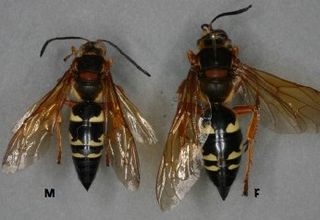
Sphecius speciosus, often simply referred to as the cicada killer or the cicada hawk, is a large, solitary digger wasp species in the family Crabronidae. The name may be applied to any species of crabronid that preys on cicadas, though in North America, it is typically applied to this species, also referred to as the eastern cicada killer in order to further differentiate it from the multiple other examples of related wasp species. Sometimes, they are called sand hornets, although they are not hornets, which belong to the family Vespidae. This species can be found in the Eastern and Midwest U.S. and southwards into Mexico and Central America. They are so named because they hunt cicadas and provision their nests with them. Cicada killers exert a measure of natural control on cicada populations, and as such, they may directly benefit the deciduous trees upon which the cicadas feed.

The European beewolf, also known as the bee-killer wasp or the bee-eating philanthus, is a solitary wasp that lives in the Western Palearctic and Afrotropics. Although the adults of the species are herbivores, the species derives its name from the behaviour of the inseminated females, who hunt Western honey bees. The female places several of its paralysed prey together with an egg in a small underground chamber, to serve as food for the wasp larvae. All members of the genus Philanthus hunt various species of bees, but P. triangulum is apparently the only one that specialises in Western honey bees.

The Bembicini, or sand wasps, are a large tribe of crabronid wasps, comprising 20 genera. Bembicines are predators on various groups of insects. The type of prey captured tends to be rather consistent within each genus, with flies (Diptera) being the most common type of prey taken. Nests are typically short, simple burrows, with a single enlarged chamber at the bottom which is stocked with freshly paralysed prey items for the developing wasp larva; the egg may sometimes be laid before the chamber is completely stocked. It is common for numerous females to excavate nests within a small area where the soil is suitable, creating large and sometimes very dense nesting aggregations, which tend to attract various species of parasitic flies and wasps, many of which are cleptoparasites; in some cases, the sand wasps prey on their own parasites, a surprisingly rare phenomenon in the animal kingdom. Although sand wasps are normally yellow and black, some are black and white with bright green eyes.

Bembix rostrata is a species of sand wasp native to Central Europe. The genus Bembix - of which B. rostrata is among the most distinctive species - has over 340 species worldwide and is found mostly in warm regions with open, sandy soils; Australia and Africa have a particularly rich variety of species.
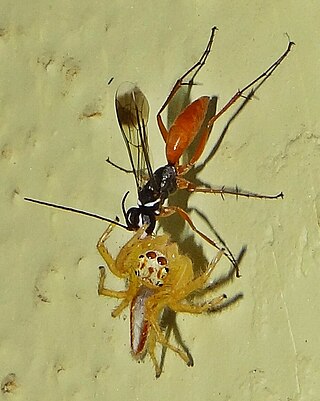
Mass provisioning is a form of parental investment in which an adult insect, most commonly a hymenopteran such as a bee or wasp, stocks all the food for each of her offspring in a small chamber before she lays the egg. This behavior is common in both solitary and eusocial bees, though essentially absent in eusocial wasps.

A wasp is any insect of the narrow-waisted suborder Apocrita of the order Hymenoptera which is neither a bee nor an ant; this excludes the broad-waisted sawflies (Symphyta), which look somewhat like wasps, but are in a separate suborder. The wasps do not constitute a clade, a complete natural group with a single ancestor, as bees and ants are deeply nested within the wasps, having evolved from wasp ancestors. Wasps that are members of the clade Aculeata can sting their prey.
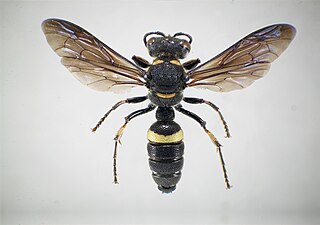
Cerceris fumipennis, the only species of buprestid-hunting Crabronidae occurring in eastern North America, is found throughout the continental United States east of the Rockies: from Texas and Florida north to Maine, Wyoming, and into Canada. The wasps most often nest in open areas of hard-packed sandy soil surrounded by woody habitat suitable for their buprestid beetle prey.
The thin-waisted social wasps, which typically reside in Neotropical regions from Central to South America, are a small genus of wasps that build nests and live in colonies ranging in size from 1 to 18 members. Microstigmus is widely considered to be the only true eusocial species within the family Crabronidae. Like all Hymenoptera, Microstigmus has an interesting sex determination pattern. Females are 2n (diploid), spawning from eggs that have been fertilized, while males are 1n (haploid) and spawn from unfertilized eggs. Female wasps contain the eggs within their egg sac and have the option of fertilizing them or not, thus having complete control of the gender of their offspring. This wasp genus, part of the suborder Apocrita, is distinguished physically by the narrow waist (petiole) between the end segment of the thorax (mesosoma) and the beginning of the abdomen (metasoma). Specifically, it is in the subgroup of "apoid wasps", those that exhibit social behavior in nesting and foraging. Evidence does exist that in some species social altruism is visible; however, studies on these topics have been limited. The small size and enclosed nest structure makes it difficult to obtain significant data. Although it was originally classified under the Sphecidae family due to its elongated petiole, Microstigmus has been reclassified into the new Crabronidae family.
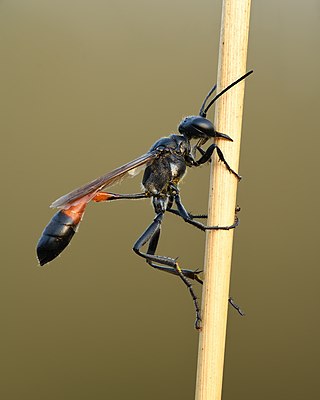
Ammophila is the type genus of the subfamily Ammophilinae of the hunting wasp family Sphecidae. Ammophila is a large and cosmopolitan genus, with over 200 species, mostly occurring in the warmer regions of all continents apart from Antarctica.
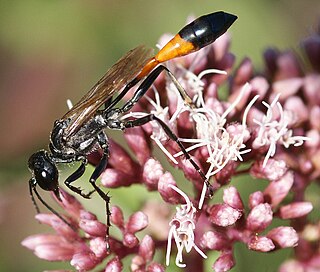
Ammophila sabulosa, the red-banded sand wasp, is a species of the subfamily Ammophilinae of the solitary hunting wasp family Sphecidae, also called digger wasps. Found across Eurasia, the parasitoid wasp is notable for the mass provisioning behaviour of the females, hunting caterpillars mainly on sunny days, paralysing them with a sting, and burying them in a burrow with a single egg. The species is also remarkable for the extent to which females parasitise their own species, either stealing prey from nests of other females to provision their own nests, or in brood parasitism, removing the other female's egg and laying one of her own instead.

Ammophila urnaria is a species of hunting wasp in the family Sphecidae. It is a black and red insect native to the eastern United States. It feeds on nectar but catches and paralyses caterpillars to leave in underground chambers for its developing larvae to consume.

Anoplius viaticus, commonly known as the black-banded spider wasp, is a species of spider wasp. These wasps are known as spider wasps because the females capture spiders to provide their offspring with food. The paralysed spider is cached in a burrow, the wasp lays an egg on it, and when this hatches, the developing wasp larva consumes the spider. This species is found in sandy heathland across most of Europe.

Podalonia hirsuta is a species of parasitoidal wasps in the family Sphecidae.
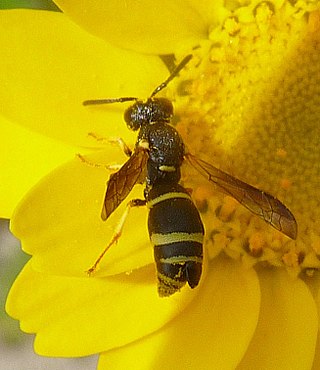
Odynerus spinipes, the spiny mason wasp, is a species of potter wasp from western Europe. It is the type species of the genus Odynerus, being first described by Carl Linnaeus in his landmark 1758 10th edition of Systema Naturae.

Pison spinolae, commonly known as mason wasp, is a solitary wasp of the family Crabronidae, found throughout New Zealand.

Ammophila placida is a species of thread-waisted wasp in the family Sphecidae. It is found in the continental United States and Central America.

Ammophila azteca is a species of thread-waisted wasp in the family Sphecidae. It is native to Canada, Mexico, and the continental United States. It is found from near-sea level to over 6,000 feet in altitude.

Ammophila aberti is a species of thread-waisted wasp in the family Sphecidae.

Palmodes occitanicus is a species of thread-waisted wasp in the family Sphecidae.





















